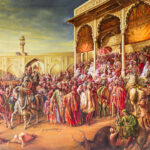What is kirpan?
As mandated by Guru Gobind Singh Ji, the kirpan, a ceremonial sword or knife holding full-size religious and symbolic significance within the Sikh faith, is one of the Five Ks—articles of faith—worn by baptized Sikhs. This includes situations such as journey by air travel, where Sikhs carry kirpan in plane, discreetly worn beneath clothing, as a visible and tangible expression of their unwavering commitment to Sikh principles and their duty to stand against injustice.
The Kirpan, specifically, is a image of courage, defense of the susceptible, and the commitment to justice and righteousness. It isn’t meant to be a weapon of aggression however as a substitute a tool for self-protection and safety. The wearing of the kirpan is a obligatory practice for baptized Sikhs, referred to as Amritdhari or Khalsa Sikhs.
Typically, the kirpan is worn in a sheath, and it is one of the articles of faith that Sikhs deliver with them at all times. The size of the kirpan can vary, and it is often discreetly worn under the garb. The kirpan serves as a steady reminder of the Sikh’s obligation to stand towards injustice and to actively uphold the values of their religion. It is a one of a kind function of Sikh identification and a illustration of the martial spirit and commitment to social justice embedded in Sikhism.

The kirpan, a ceremonial sword or knife, holds profound religious importance for Sikhs. It symbolizes the values of braveness, protection of the vulnerable, and the unwavering dedication to justice and righteousness. As a seen and tangible representation of those concepts, the kirpan serves not most effective as an article of faith but additionally as a constant reminder for Sikhs to uphold their moral and ethical obligations.
Wearing a Kirpan is a specific and fundamental element of Sikh identification, reflecting the deep non secular convictions and commitment to principles in the Sikh religion. Sikhs, who comply with the teachings of Sikhism, one of the international’s youngest religions, proudly don the kirpan as one of the Five Ks, a hard and fast of articles of religion mandated through Guru Gobind Singh, the 10th Sikh Guru.
The sporting of the kirpan isn’t merely a customary exercise but a sacred responsibility for baptized Sikhs, called Amritdhari or Khalsa Sikhs. The kirpan, worn discreetly underneath garb, is a image of readiness to shield and assist the ones in need, aligning with Sikh teachings that emphasize the pursuit of justice and status against oppression.
As Sikhs engage with the current international, questions arise approximately the compatibility of traditional practices, which includes sporting the kirpan, with contemporary contexts like air journey. Navigating those intersections involves a sensitive balance among religious freedom, protection protocols, and adherence to aviation rules. Understanding the cultural and spiritual significance of the kirpan gives a basis for appreciating the complexities that Sikhs face as they strive to maintain their identification while collaborating inside the worldwide network.
The Kirpan: Symbolism and Significance
The Kirpan is a ceremonial dagger that holds outstanding importance in Sikhism, one of the global’s important religions. It is one of the Five Ks, which might be the five articles of religion that initiated Sikhs are required to wear. The Five Ks constitute the Sikh identification and the dedication to the Sikh manner of life.
Here are a few key factors approximately wearing a Kirpan:
Symbolism and Significance:
The Kirpan symbolizes courage, self-defense, and the struggle for justice.It serves as a reminder to Sikhs of their responsibility to guard the oppressed and uphold righteousness.
Religious Requirement:
The Kirpan is a obligatory article of faith for initiated Sikhs, and its presence is a symbol in their commitment to Sikhism.It is one of the Five Ks at the side of Kesh (uncut hair), Kara (metal bracelet), Kanga (timber comb), and Kachera (cotton undergarments).
Size and Design:
The size and design of the Kirpan can vary, however it’s far usually a small sword with a curved blade.Sikhs are endorsed to carry a Kirpan this is practical and plausible for each day life.

Legal and Safety Issues:
Wearing a Kirpan has led to criminal and safety concerns in a few countries and contexts.Sikhs have confronted demanding situations in areas in which legal guidelines limit the carrying of weapons, as the Kirpan is considered a non secular image as opposed to a weapon.
Educational and Cultural Outreach:
Sikh groups frequently engage in educational efforts to raise attention about the Kirpan and its non secular significance.Outreach applications purpose to foster know-how and tolerance, dispelling misconceptions surrounding the Kirpan.
Global Perspectives:
Different nations have various policies regarding the Kirpan, and Sikhs engage in dialogues with authorities to deal with worries even as respecting their religious practices.
International and National Regulations:
In navigating the complicated realm of global and country wide guidelines, the popularity of the kirpan’s spiritual importance stands as a testomony to the worldwide acknowledgment of non secular freedom. Many nations recognize the centrality of the kirpan in the Sikh religion and permit its presence in public areas. However, the transition to air tour introduces a nuanced measurement to this reputation.
Each nation grapples with the delicate task of formulating rules that strike a sensitive equilibrium between honoring spiritual freedoms and upholding the paramount obligation of making sure the protection and security of all passengers aboard an aircraft. These regulations can also embody specs regarding the permissible length of the kirpan, mandates for secure sheathing to save you unintentional harm, and recommendations for the correct carriage of this sacred article. By analyzing and expertise the particular regulations of the departure and arrival countries, Sikh travelers can put together themselves for a journey that respects each their faith and the imperative of aviation protection.

Airline Policies:
When human airways, as independent creatures, set their own rules about non-religious objects like the kirpan, the complexity increases. The rainbow of airline policies may also cover a variety of topics, including the application of extra screening procedures, requirements for safe sheathing to guarantee in-flight security, and limitations on the size of the kirpan.
For Sikh passengers proceeding to tour with a kirpan, thorough scrutiny of the regulations set forth with the aid of the chosen airline will become a essential prelude to their adventure. Contacting the airline nicely in advance serves as a proactive degree, taking into account a clear understanding of the unique requirements and facilitating a smoother journey revel in. This preemptive communique may additionally involve searching for clarification on any ambiguous factors within the airline’s coverage, ensuring that the passenger is properly-informed and may adhere to the rules without compromising their religious convictions. As these policies are situation to trade, staying updated with the today’s pointers of the selected airline is vital, offering a foundation for a harmonious stability among non secular expression and aviation compliance.
Size and Sheathing Considerations:
The length of the kirpan emerges as a pivotal factor influencing its acceptability at some stage in air travel. Many countries and airlines stipulate particular regulations concerning the permissible period of the kirpan’s blade. These guidelines are crafted with a dual motive: to honor the non secular importance of the kirpan for Sikhs and, simultaneously, to mitigate ability security dangers. By delineating unique blade lengths, authorities searching for to strike a balance that upholds religious freedoms while ensuring that the kirpan remains a symbol of religion in place of posing any capacity danger for the duration of the flight.
Secure sheathing is another important dimension in this regulatory framework. Mandated via numerous jurisdictions and airways, it serves as a safety measure in opposition to unintentional damage or misuse at some point of the course of the flight. The requirement for steady sheathing no longer best enhances the safety of all passengers however additionally underscores the commitment to accommodating non secular practices within the confines of aviation safety protocols.
Security Screening and Documentation:
Sikh passengers carrying a kirpan need to expect extra protection screening strategies at airports. In light of the kirpan’s symbolic and spiritual importance, informing protection personnel earlier approximately its presence can facilitate a smoother and more respectful screening method. This proactive verbal exchange lets in security workforce to enforce necessary measures whilst being aware of the sacred nature of the kirpan.
In a few instances, government or airways might also necessitate documentation to validate the non secular nature of the kirpan. A letter from a identified Sikh organization or a religious chief can serve as a form of authentication. This documentation requirement, while an brought step, contributes to a more comprehensive information of the religious context and aids in distinguishing the kirpan as a sacred article in preference to a protection difficulty.
Embarking on air journey with a kirpan calls for a nuanced understanding of the interaction between religious rights, security features, and regulatory landscapes. By meticulously adhering to global, country wide, and airline-particular recommendations, Sikh vacationers embark on a adventure that respects both their cherished faith and the imperative of air journey safety. In navigating those issues with diligence and consciousness, Sikhs can convey their kirpan, a symbol of braveness and commitment, throughout the skies, bridging the realms of spirituality and modernity.








